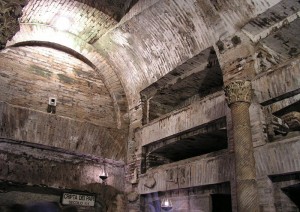Rome, Italy
In the search for early Christian architecture, there is virtually nothing left above ground that was constructed prior to the 4th century that is not now a ruin or renovated beyond recognition. To find Christianity’s oldest intact architectural achievements, one must look below ground, to the ancient burial places known as Catacombs. Although such underground tomb complexes had been used in lands and cultures around the world since antiquity, it was the Christians of Rome and other cities in Italy who raised catacomb building to an art form. From simple entrances scattered along the ancient Roman roadsides, the Christian catacombs spread like labyrinths, sometimes hundreds of acres in size and as many as five levels deep. Since the 19th century, dozens of catacomb complexes have been rediscovered around Rome, and some of these are now open to the public and are popular tourist attractions.
History
The use of secret underground burial chambers in the area around Rome dates back at least to Etruscan times, though such expensive and labor-intensive constructions were usually reserved for wealthy families. Such practices were likely continued in early Roman times, albeit on an extremely small scale, as few such examples from that period have ever been found. It was not until the early 2nd century AD that the mass construction of the immense labyrinths would come into vogue in the area around the imperial capital.
Several cultural, religious and logistical needs all seemed to have come about at this time, necessitating a new way to dispose of Rome’s dead and ushering in the empire’s golden age of catacomb building. Among other things, the burial of corpses was generally coming into vogue in the empire in the 2nd century, as opposed to the traditional act of cremation. This was particularly true among the Christian population, who may in fact have influenced the local pagans in this regard. Rome, the most populous city in the world, had no room inside the city for such a large number graves, and a law was passed requiring all burials to be moved outside of the walls.
For most pagan Romans this meant tombs and graves scattered along the roads and in the countryside outside of Rome. But Christians had other concerns, including secrecy. The 2nd and 3rd centuries were a period of great persecution for the Christians of Rome, and many of the gravesites of their 1st century brethren had been desecrated on a regular basis. Underground burials with minimal access to the surface made Christian tombs both less accessible and a less obvious target. Furthermore, many saints and martyrs were buried in the catacombs in earlier times, and many Christians simply wanted to be buried near them.
By the beginning of the 3rd century AD, the use of catacombs had spread beyond Rome, although it remained primarily a phenomenon of Italy. Catacombs sprang up in a number of cities throughout the Italian Peninsula, as well as in some of the islands of the Mediterranean. Among the better known of these are the catacomb systems of Syracuse and Malta. The age of the catacombs began to decline late in the 4th century, when Christians were solidly in control of the empire and could at last move their tombs above ground. A few centuries later the Catacombs of Rome were abandoned entirely, and forgotten until their rediscovery in the late 1500s.
Visiting
There are over a score of Christian catacombs along the ancient Roman roads leading into the city. Of these, a few stand out. The Catacombs of Domatilla were possibly the earliest and one of the first to be rediscovered, as well as one of the largest and most intact. It is also the only one which still contains early Christian relics at least that have so far been discovered. The Catacombs of Domatilla are also famous for a large, carved-out underground basilica which is the architectural centerpiece of the complex.
The Catacombs of San Sebastian, located beneath the Church of San Sebastian Outside the Wall, are among the most visited as San Sebastian’s was once one of the Seven Pilgrimage Churches of Rome. However, they are also among the smallest. The early Christian martyr St. Sebastian was once interred here, and a small statue of the saint created by the Renaissance artist Bernini marks the former location of his tomb. The Catacombs of San Callisto were among the largest and most prestigious in early Christian times. Aside from the numerous saints and martyrs who were once entombed there, San Callisto served for a time as the official burial site of the Bishops of Rome, and more than a dozen early Popes were interred within.
Most of Rome’s various catacomb systems are located some distance outside of central Rome, and will generally require transportation or a tour to reach. All three of the above catacombs, along with a few of the others, are open year-round except during parts of the winter when repairs and maintenance are done (check in advance). Hours are 9:00am-5:00pm (closed for lunch noon-2:00pm). San Sebastian is closed on Sundays; Domatilla is closed on Tuesdays; and Callisto is closed on Wednesdays. The cost of admission is E6.00 for Callisto and E5.00 for the others. Web: www.catacombe.roma.it (official website)
Other sites
Of the other Christian Catacombs of Rome, two others can also be visited: the Catacomb of Priscilla, and the Catacomb of Sant’Agnese. Several others, including the Catacombs of Commodilla, the Catacombs of Marcellinus & Peter, and the Catacombs of Praetextatus, contain tombs and artwork of interest, but are currently closed to the public. This is also true of the Jewish Catacombs of Villa Torlonia, which is currently off-limits due to its hazardous condition. For those who wish to see one of Rome’s creepiest Catholic ossuaries still in use, there is also the 17th century Capuchin Crypt, which displays the bones of as many as 4,000 former monks.

Leave a Reply